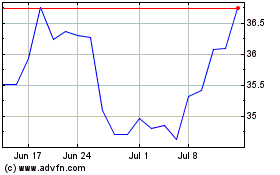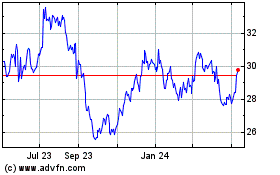HP Reports Lower Earnings, Revenue
August 24 2016 - 4:50PM
Dow Jones News
HP Inc.'s revenue and earnings shrank in the most recent
quarter, but the company showed signs of success in stabilizing the
personal-computer business that is its largest revenue source.
The company said revenue from its personal systems business was
flat in the third fiscal quarter after five quarters of declines,
with unit PC sales up 4%. Revenue declined 14% in its printing
segment—which generates most of HP's profits—reflecting the fact
that users now print less than they once did.
But HP pointed to signs of improvement in that business as well,
and the company's revenue and profit topped analyst
expectations.
Dion Weisler, HP's chief executive, said he was "incredibly
pleased" with the progress the company made in the quarter.
HP became independent last year as part of the breakup of the
former Hewlett-Packard Co. While its two major businesses have
failed to grow, its stock is up more than 20% in the year because
it generates a steady flow of cash, much of which it uses for
dividends and stock buybacks.
The company on Wednesday said it generated $1 billion in free
cash flow in the third quarter, indicating it should meet a target
of generating $2 billion to $2.3 billion in free cash flow for the
fiscal year ending in October.
The No. 2 PC maker behind Lenovo Group Ltd., HP has suffered
along with its peers as consumer spending has shifted to products
such as smartphones. But market researchers recently concluded that
the rate of decline had moderated in the second quarter.
International Data Corp. in July estimated HP's global quarterly
PC shipments rose 5.1%, though the overall PC market fell 4.5%. Mr.
Weisler has been pushing the company to focus on faster-growing
parts of the market that command higher profit margins, such as
gaming PCs and premium notebook models.
He said Wednesday that the strategy is paying off, as HP gained
market share and average sales prices for consumer sales rose in
the latest quarter.
The numbers are less rosy on the printer side. HP on Wednesday
said revenue from toner and ink supplies fell 18%, while printing
hardware unit sales slid 10%.
Another factor affecting HP's results concerns how it markets
ink and toner and the amounts of those products held by its dealers
and distributors. Mr. Weisler in June announced a strategy shift
aimed at reducing distributor inventories and moving away from
using periodic promotions to drive demand.
HP at the time predicted printing supplies revenue would go down
by about $225 million in its fiscal third and fourth quarters
because of the reduction of inventory in its sales channels. But it
predicted that much of the revenue reduction would be offset by
proceeds from the deal to sell some software assets to OpenText
Corp.
In all, HP reported that earnings for the period ended July 31
declined 8% to $783 million, or 45 cents per share, from the
year-earlier figures of $854 million, or 47 cents a share. Revenue
fell 4% to $11.89 billion.
On an adjusted basis that excludes one-time items, HP put
earnings per share at 48 cents. The company in June estimated
per-share earnings on that basis between 43 cents and 46 cents.
Analysts polled by Thomson Reuters had projected, on average, 44
cents a share in earnings on revenue of $11.4 billion.
For the fiscal fourth quarter ending in October, HP said it
expects to report adjusted earnings of 34 cents to 37 cents a
share. The average analyst estimate was for earnings of 41 cents a
share, according to Thomson Reuters. HP didn't provide a revenue
projection.
Write to Don Clark at don.clark@wsj.com
(END) Dow Jones Newswires
August 24, 2016 16:35 ET (20:35 GMT)
Copyright (c) 2016 Dow Jones & Company, Inc.
HP (NYSE:HPQ)
Historical Stock Chart
From Mar 2024 to Apr 2024

HP (NYSE:HPQ)
Historical Stock Chart
From Apr 2023 to Apr 2024
